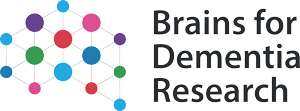For the general public
This section is designed to give a plain English overview of our science, in the hope of making our work as accessible as possible to the broadest range of people. Broadly speaking, we are interested in diseases that affect the brain and cause the death of brain cells. These conditions are typically referred to as "neurodegenerative diseases" as they cause the death (or degeneration) of brain cells (neurons).
There are many diseases that cause neurodegeneration, the most common of which is called Alzheimer's disease (AD). Much of our work is focused on the second most common neurodegenerative disease, Lewy body dementia (LBD). LBD can sometimes be a confusing term as it can refer to several related concepts, the following terms are often used:
- Lewy body disease - all diseases in which Lewy bodies are found, including Parkinson's disease, Parkinson's disease dementia, pure autonomic failure, incidental Lewy body disease and dementia with Lewy bodies.
- Lewy body dementia - this refers to all dementia disorders in which Lewy bodies are found, so this only refers to Parkinson's disease dementia and dementia with Lewy bodies.
- Dementia with Lewy bodies - this is a disorder in which dementia either comes before, or at the same time as, a movement disorder.
- Parkinson's disease dementia - this is a disorder in which dementia occurs after a movement disorder.
We also study diseases that seem to involve similar processes to LBD. These are typically rare genetic conditions that are often caused by genes we know to be involved in LBD, these include:
- Lysosomal storage disorders - these are diseases caused by dysfunction of lysosomes, the parts of cells that break down waste. This leads to the accumulation of waste products, which can be harmful to all cells, but often brain cells are especially vulnerable as they accumulate lots of waste as they live longer than most other types of cells so accumulate much more waste. We are especially interested in metachromatic leukodystrophy, a disease that often affects very young children.
- Mitochondrial diseases - these are diseases caused by dysfunction of mitochondria, the parts of cells that produce energy. This leads to problems producing energy, which can be harmful to all cells, but often brain cells are especially vulnerable as they are very active; therefore, they need lots of energy to perform their normal functions. We have particular interestes in mitochondrial diseases caused by a gene called POLG.
To study diseases of the brain, we often use post-mortem human brain tissue as they show us how these diseases affect the brain. Although this seems an unusual approach, this is actually very important in our opinion. Many people use "models" of disease in a lab, and this involves creating the disease in cells or mice. This is difficult for conditions like LBD, simply because we don't actually know what causes these diseases so it is really difficult to make it in cells or mice. However, it is also important to note that post-mortem tissue usually shows us what happens at the end of the disease and it is hard to know what changes in the brain came first. This is why we often use models like cells in addition to our human brain tissue work, so we can test processes we find to be altered in brain tissue. We think this is the best way to perform our research, as each approach compensate for weaknesses in the other.
We are especially interested in how the metabolism of brain cells becomes changed in these diseases, as we think this might cause or contribute to these diseases. Metabolism is a broad term but it basically means the chemical processes that cells perform to sustain life and carry out their normal functions. We have special interests in how cells produce energy using a part of the cell called mitochondria and how they get rid of their waste using a process called autophagy. In the column to the left, we have plain English summaries of our current projects on these subjects.







